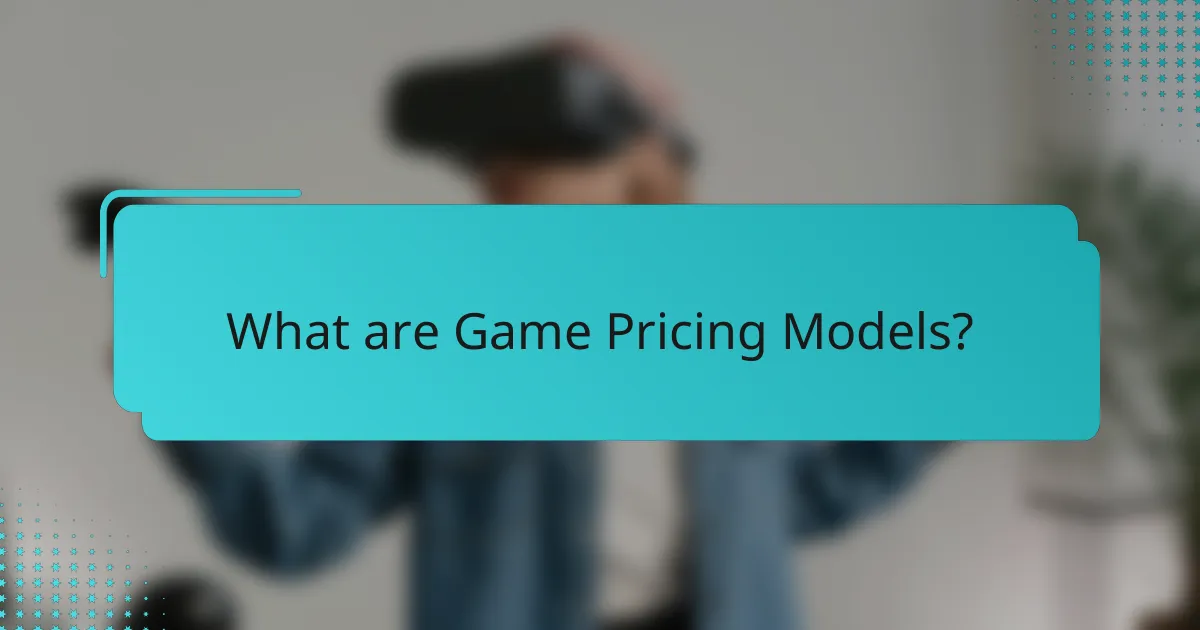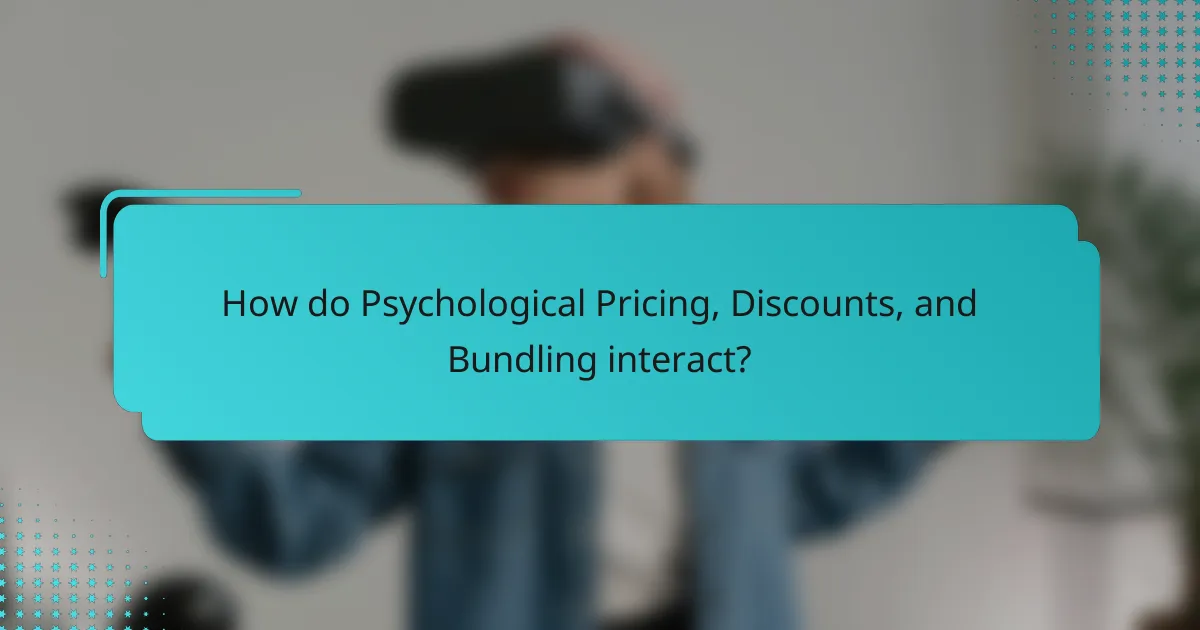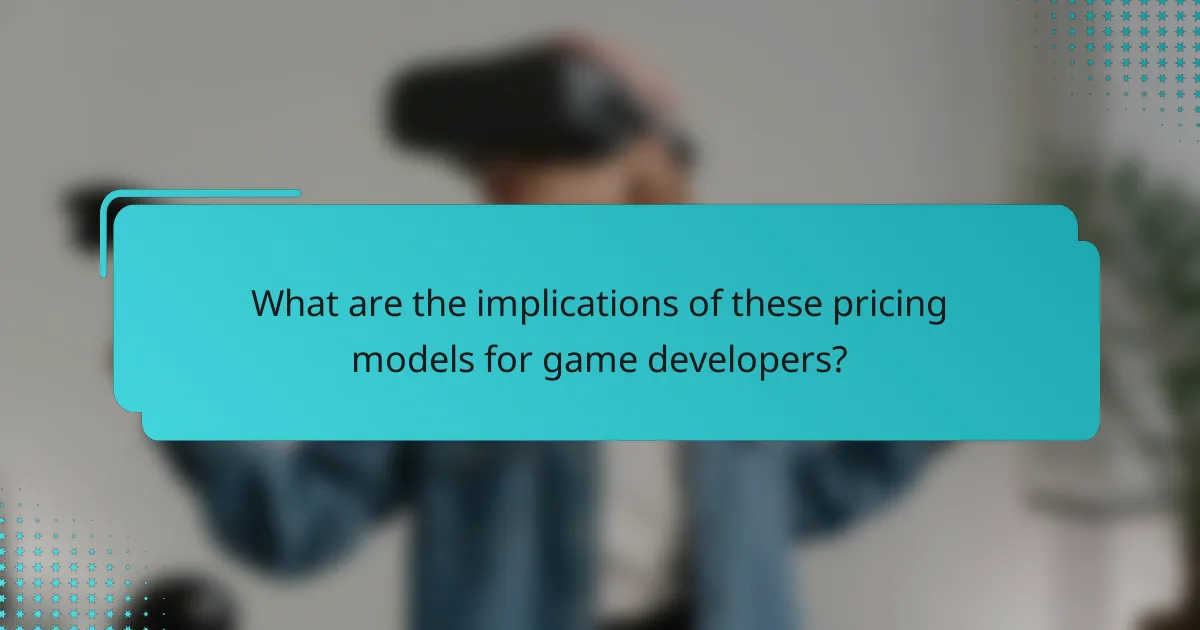
What are Game Pricing Models?
Game pricing models refer to the various strategies used to set the price of video games. These models can influence consumer behavior and sales performance. Common pricing models include premium pricing, freemium, subscription, and pay-to-play. Premium pricing involves charging a higher upfront cost for a game. Freemium models offer a free base game with optional paid features. Subscription models charge players a recurring fee for access to a library of games. Pay-to-play requires payment for each game or level accessed. Each model has distinct advantages and can be tailored to target specific audiences.
How do Psychological Pricing Strategies influence consumer behavior?
Psychological pricing strategies influence consumer behavior by creating perceptions of value and affordability. These strategies often utilize pricing techniques that make products appear less expensive. For example, pricing an item at $9.99 instead of $10 can lead consumers to perceive it as a better deal. Research shows that this tactic can increase sales by up to 24%.
Additionally, consumers are more likely to engage with products that use charm pricing, which appeals to their emotions. This emotional response can lead to impulse purchases. A study by Thomas and Morwitz found that charm pricing significantly increases demand for products.
Moreover, psychological pricing can enhance the perceived quality of a product. Higher prices can imply better quality, affecting consumer choices. According to a study published in the Journal of Consumer Research, consumers often associate higher prices with superior product performance.
Thus, psychological pricing strategies effectively shape consumer perceptions and behaviors, driving purchasing decisions.
What are the key principles behind psychological pricing?
Psychological pricing is a strategy that leverages consumer behavior to influence purchasing decisions. One key principle is the use of charm pricing, which involves setting prices just below a round number, such as $9.99 instead of $10. This creates a perception of value. Another principle is the anchoring effect, where consumers rely on the first piece of information encountered, such as a higher original price, to assess the deal’s attractiveness. Additionally, tiered pricing can encourage consumers to choose a mid-range option, making it appear more appealing. Research indicates that these techniques can significantly increase sales and customer satisfaction. Studies show that charm pricing can lead to a 24% increase in sales compared to rounded pricing.
How can psychological pricing create perceived value?
Psychological pricing creates perceived value by leveraging consumer psychology to influence purchasing decisions. It often involves setting prices just below a round number, such as $9.99 instead of $10. This tactic makes the price appear lower and more attractive. Research shows that consumers perceive prices ending in ‘.99’ as significantly cheaper than those rounded up. Additionally, this pricing strategy can evoke feelings of getting a deal, enhancing the overall value perception. A study by Thomas and Morwitz (2009) in the “Journal of Consumer Research” found that psychological pricing can increase sales volume by creating a perception of savings. Thus, psychological pricing effectively shapes consumer perceptions and drives purchasing behavior.
What role do Discounts play in game pricing?
Discounts play a significant role in game pricing by influencing consumer purchasing decisions. They create a sense of urgency and encourage immediate purchases. Discounts can also enhance perceived value, making games more attractive to potential buyers. Research indicates that price reductions can lead to increased sales volume. For example, a study by the NPD Group found that discounted games often see a sales increase of up to 50%. Additionally, discounts can help clear inventory and attract price-sensitive customers. Overall, discounts are a strategic tool in pricing models that can drive revenue and market [censured].
What types of discounts are commonly used in the gaming industry?
Common types of discounts in the gaming industry include seasonal sales, bundle deals, and promotional discounts. Seasonal sales typically occur during holidays or special events, offering substantial price reductions. Bundle deals allow consumers to purchase multiple games or content packages at a lower combined price. Promotional discounts are often used to attract new players or encourage purchases of specific titles. For instance, platforms like Steam frequently host sales events, with discounts ranging from 10% to 90% on various games. These strategies are effective in driving sales and increasing player engagement.
How do seasonal sales impact game pricing strategies?
Seasonal sales significantly influence game pricing strategies. Game developers and retailers often reduce prices during these sales to attract more buyers. This reduction can lead to increased sales volume, especially during major events like Black Friday or holiday seasons. Discounts create a sense of urgency, prompting consumers to purchase games they might have otherwise ignored.
Additionally, seasonal sales can help clear inventory before new releases. This strategy ensures that older titles do not linger on shelves, maximizing revenue potential. Research indicates that consumers are more likely to buy during promotional periods, with studies showing sales can increase revenue by up to 30%.
Furthermore, seasonal pricing can enhance brand loyalty. Customers who perceive they are getting a good deal may return for future purchases. Overall, seasonal sales are a critical component of game pricing strategies, driving both immediate sales and long-term customer engagement.
What is Bundling in the context of game pricing?
Bundling in the context of game pricing refers to the practice of offering multiple games or content together as a single package. This strategy often provides a discount compared to purchasing each item separately. Bundling can increase perceived value for consumers. It encourages players to try more games they might not have purchased individually. Additionally, bundling can help developers clear out inventory or promote less popular titles. Evidence shows that bundled offerings can lead to higher overall sales. For example, Steam often uses bundles to boost sales during seasonal sales events.
How does bundling enhance the value proposition for consumers?
Bundling enhances the value proposition for consumers by offering multiple products or services together at a reduced price. This approach creates perceived savings compared to purchasing items individually. Consumers often feel they receive more value for their money when bundled offers are presented. Research indicates that 70% of consumers are more likely to purchase when they perceive a bundled discount. Bundling can also simplify decision-making for consumers, reducing the time spent evaluating individual options. Additionally, it may increase customer satisfaction by providing a comprehensive solution to their needs. By combining products, companies can differentiate themselves in a competitive market, further enhancing the perceived value for consumers.
What are the best practices for implementing bundling strategies?
Best practices for implementing bundling strategies include understanding customer needs and preferences. Analyze market data to identify popular product combinations. Create bundles that offer perceived value and savings. Ensure that the bundled products complement each other effectively. Test different pricing strategies for bundles to find the most appealing price point. Communicate the benefits of the bundle clearly to customers. Monitor sales performance and customer feedback to refine bundling strategies. Research shows that effective bundling can increase sales by up to 30% when done correctly.

How do Psychological Pricing, Discounts, and Bundling interact?
Psychological pricing, discounts, and bundling interact to influence consumer purchasing behavior. Psychological pricing involves setting prices that have a psychological impact, such as $9.99 instead of $10. Discounts provide temporary price reductions, creating urgency and perceived value. Bundling combines multiple products into a single package, often at a lower price than purchasing items individually.
These strategies can amplify each other’s effectiveness. For instance, a discount on a bundled offer can enhance the perception of savings. Research shows that consumers are more likely to purchase when they perceive they are getting a deal. A study by the Journal of Marketing found that psychological pricing can increase sales by up to 24% when combined with discounts.
In summary, the interaction among these pricing strategies creates a compelling value proposition that drives consumer purchases.
What is the relationship between psychological pricing and discounts?
Psychological pricing and discounts are interconnected strategies in pricing models. Psychological pricing aims to influence consumer perception by setting prices that appear lower than they are, such as $9.99 instead of $10. Discounts, on the other hand, offer a temporary reduction in price to stimulate sales. Both strategies leverage consumer psychology to enhance perceived value. For example, a product priced at $100 may be discounted to $80, creating a sense of urgency and value. Research shows that consumers are more likely to purchase items perceived as being on sale, reinforcing the effectiveness of both methods.
How can discounts be used to complement psychological pricing strategies?
Discounts can enhance psychological pricing strategies by creating a perception of value. When a product is priced just below a round number, discounts can reinforce this perception. For example, pricing an item at $9.99 and offering a 20% discount can make the final price feel like an exceptional deal. This aligns with consumer behavior, as studies show that consumers are more likely to perceive discounts as significant when they are applied to psychologically priced items. Additionally, discounts can create urgency, prompting quicker purchasing decisions. Research indicates that limited-time offers can increase sales by up to 30%. Overall, combining discounts with psychological pricing can effectively drive consumer interest and boost sales.
How can bundling be effectively combined with discounts?
Bundling can be effectively combined with discounts by offering a reduced price for a group of products. This strategy encourages customers to purchase more items together. For example, a game publisher might bundle multiple games and offer a discount on the total price compared to buying each game individually. Research shows that consumers perceive bundled offers as having higher value. According to a study by Gaur et al. (2019), bundled pricing can increase sales by up to 30%. Additionally, clear communication of the savings involved enhances customer perception of the deal. This approach not only boosts sales but also improves customer satisfaction.
What are the potential pitfalls of combining discounts with bundling?
Combining discounts with bundling can lead to several potential pitfalls. First, it may reduce perceived value. Customers might believe that discounted bundles indicate lower quality. Second, profit margins can be negatively impacted. Offering discounts reduces revenue per unit sold. Third, it can confuse customers. Complex pricing structures may overwhelm them, leading to decision paralysis. Fourth, it risks devaluing individual products. Customers might wait for bundles instead of purchasing items at full price. Lastly, it can lead to inventory issues. Bundling may not align with actual stock levels, causing supply chain challenges. These pitfalls highlight the need for careful strategy when implementing discounts with bundling.

What are the implications of these pricing models for game developers?
Pricing models significantly impact game developers’ revenue and market strategy. These models influence consumer behavior and purchasing decisions. For instance, psychological pricing can create a perception of value, encouraging more purchases. Discounts can attract price-sensitive consumers, boosting sales volume. Bundling strategies can increase the average transaction size by offering multiple games at a perceived discount.
Moreover, the choice of pricing model affects the game’s positioning in the market. Developers must consider their target audience’s preferences and spending habits. Research shows that well-implemented pricing strategies can lead to increased customer loyalty. Ultimately, the right pricing model can enhance profitability and sustain long-term growth for game developers.
How can game developers optimize pricing strategies for maximum profit?
Game developers can optimize pricing strategies for maximum profit by utilizing dynamic pricing, psychological pricing, and bundling strategies. Dynamic pricing allows developers to adjust prices based on demand and player behavior. This approach can increase revenue during peak times and attract more players during off-peak periods. Psychological pricing involves setting prices just below whole numbers, making them appear more attractive. For example, pricing a game at $19.99 instead of $20 can influence purchasing decisions.
Bundling strategies can also enhance perceived value. By offering multiple games or in-game content together at a discounted rate, developers can increase overall sales. Research shows that bundled offers can lead to a 20-30% increase in average transaction value. Additionally, implementing limited-time discounts can create urgency, encouraging players to purchase before the offer expires. These strategies combined can effectively maximize profit while enhancing player satisfaction.
What tools and metrics can developers use to analyze pricing effectiveness?
Developers can use various tools and metrics to analyze pricing effectiveness. Key tools include analytics platforms like Google Analytics and Mixpanel. These platforms track user behavior and sales data. Metrics such as conversion rates and average revenue per user (ARPU) provide insights into pricing performance. Additionally, A/B testing tools like Optimizely help test different pricing strategies. Customer feedback tools can also gauge user perception of pricing. Using these tools and metrics allows developers to make data-driven decisions about pricing strategies.
What are the best practices for implementing these pricing models?
Best practices for implementing pricing models include conducting thorough market research. Understanding customer preferences is crucial for effective pricing strategies. Utilizing psychological pricing can enhance perceived value. For example, pricing items at $9.99 instead of $10 can influence buying decisions. Offering discounts strategically can increase sales volume while maintaining profit margins. Bundling products can also encourage customers to purchase more items together. Monitoring competitor pricing helps ensure competitiveness in the market. Regularly reviewing pricing models based on sales data is essential for ongoing optimization. These practices align with industry standards for maximizing revenue and customer satisfaction.
How can developers test and refine their pricing strategies over time?
Developers can test and refine their pricing strategies over time by utilizing A/B testing. This method allows them to present different price points to segments of their audience. By analyzing the conversion rates and sales data, developers can identify which pricing strategy performs better. Additionally, they can gather customer feedback through surveys to understand perceived value. Monitoring market trends and competitor pricing is also crucial. Developers should adjust their strategies based on these insights. Regularly reviewing analytics helps in making informed decisions. This iterative process supports continuous improvement of pricing strategies.
What common mistakes should developers avoid when setting game prices?
Developers should avoid several common mistakes when setting game prices. One mistake is failing to conduct market research. Understanding competitors’ pricing helps position the game effectively. Another mistake is neglecting the perceived value of the game. High-quality graphics and engaging gameplay can justify higher prices. Setting prices too low can devalue the game and lead to lower revenue. Conversely, pricing too high can deter potential buyers. Additionally, ignoring player demographics can result in mispricing. Different audiences have varying willingness to pay. Developers should also avoid rigid pricing strategies. Flexibility allows for adjustments based on market response. Lastly, overlooking the impact of discounts can be detrimental. Strategic discounts can boost sales and attract new players.
Game pricing models encompass various strategies that determine the price of video games, including premium pricing, freemium, subscription, and pay-to-play. This article explores how psychological pricing strategies influence consumer behavior, the role of discounts in driving sales, and the impact of bundling on perceived value. Key principles of psychological pricing, such as charm pricing and the anchoring effect, are examined alongside common discount types and their effects during seasonal sales. Additionally, best practices for implementing these pricing strategies are discussed, highlighting their implications for game developers aiming to optimize revenue and enhance customer engagement.